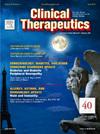使用聚adp核糖聚合酶抑制剂的卵巢癌患者周围神经病变:基于美国食品和药物管理局不良事件报告系统的贝叶斯歧化分析的真实世界研究。
IF 3.6
4区 医学
Q2 PHARMACOLOGY & PHARMACY
引用次数: 0
摘要
目的:本研究的目的是利用美国食品和药物管理局不良事件报告系统,从安全性信号方面分析聚adp核糖聚合酶抑制剂治疗上皮性卵巢癌、输卵管癌和原发性腹膜癌(简称EOC)的不良事件,并对其报告率、严重程度和周围神经病变结局的构成比进行两两比较。方法:收集2015年第一季度至2024年第三季度提交给美国食品和药物管理局不良事件报告系统的与EOC治疗相关的周围神经病变报告数据。确定了三种聚adp核糖聚合酶抑制剂:奥拉帕尼,尼拉帕尼和鲁卡帕尼。本研究的主要综合终点是接受聚adp核糖聚合酶抑制剂治疗的EOC患者周围神经病变的安全信号,而次要终点包括感觉神经病变、自主神经病变和运动神经病变的安全信号。所有分析均使用Stata 18.0 MP软件进行。结果:共纳入300810份符合条件的记录,其中周围神经病变报告70332份。对于主要的复合终点,使用尼拉帕尼检测到与周围神经病变相关的安全信号(报告优势比[ROR] = 1.47;信息成分[IC]025 = 0.21),而奥拉帕尼或鲁卡帕尼未发现安全信号。对于次要终点,使用尼拉帕尼检测与自主神经、感觉和运动神经病变相关的安全信号(ROR = 1.42, IC025 = 0.21;Ror = 1.39, ic025 = 0.20;ROR = 1.31, IC025 = 0.17),而奥拉帕尼和鲁卡帕尼未发现信号。意义:对于EOC患者,在给予尼拉帕尼时应谨慎监测周围神经病变。当然,需要进行更大规模和长期的随访期研究。本文章由计算机程序翻译,如有差异,请以英文原文为准。
Peripheral Neuropathy in Patients With Ovarian Cancer Administrating Poly ADP-Ribose Polymerase Inhibitors: A Real-World Study Based on Bayesian Disproportionality Analysis of the US Food and Drug Administration Adverse Event Reporting System
Purpose
The aim of this study was to analyze adverse events in terms of safety signals and conduct pairwise comparisons on the constituent ratios of the reporting rates, severity, and outcomes of peripheral neuropathy among poly ADP-ribose polymerase inhibitors in the treatment of epithelial ovarian cancer, fallopian tube cancer, and primary peritoneal cancer (collectively referred to as EOC) leveraging the US Food and Drug Administration Adverse Event Reporting System.
Methods
Data on peripheral neuropathy reports related to EOC treatment submitted to the US Food and Drug Administration Adverse Event Reporting System from the first quarter of 2015 to the third quarter of 2024 were collected. Three poly ADP-ribose polymerase inhibitors are identified: olaparib, niraparib, and rucaparib. The primary composite end point of this study was the safety signals for peripheral neuropathy in patients with EOC receiving poly ADP-ribose polymerase inhibitors treatment, whereas the secondary end points included the safety signals for sensory neuropathy, autonomic neuropathy, and motor neuropathy. All analyses were conducted using Stata 18.0 MP software.
Findings
A total of 300,810 eligible records were included, among which there were 70,332 reports of peripheral neuropathy. For the primary composite end point, a safety signal related to peripheral neuropathy was detected with niraparib (reporting odds ratio [ROR] = 1.47; information component [IC]025 = 0.21), whereas no safety signal was found with olaparib or rucaparib. For the secondary end points, safety signals related to autonomic, sensory, and motor neuropathies were detected with niraparib (ROR = 1.42, IC025 = 0.21; ROR = 1.39, IC025 = 0.20; ROR = 1.31, IC025 = 0.17), whereas no signals were identified with olaparib and rucaparib.
Implications
For patients with EOC, prudent surveillance of peripheral neuropathy is warranted when administrating niraparib. Certainly, more large-scale and long-term follow-up period studies were entailed.
求助全文
通过发布文献求助,成功后即可免费获取论文全文。
去求助
来源期刊

Clinical therapeutics
医学-药学
CiteScore
6.00
自引率
3.10%
发文量
154
审稿时长
9 weeks
期刊介绍:
Clinical Therapeutics provides peer-reviewed, rapid publication of recent developments in drug and other therapies as well as in diagnostics, pharmacoeconomics, health policy, treatment outcomes, and innovations in drug and biologics research. In addition Clinical Therapeutics features updates on specific topics collated by expert Topic Editors. Clinical Therapeutics is read by a large international audience of scientists and clinicians in a variety of research, academic, and clinical practice settings. Articles are indexed by all major biomedical abstracting databases.
 求助内容:
求助内容: 应助结果提醒方式:
应助结果提醒方式:


